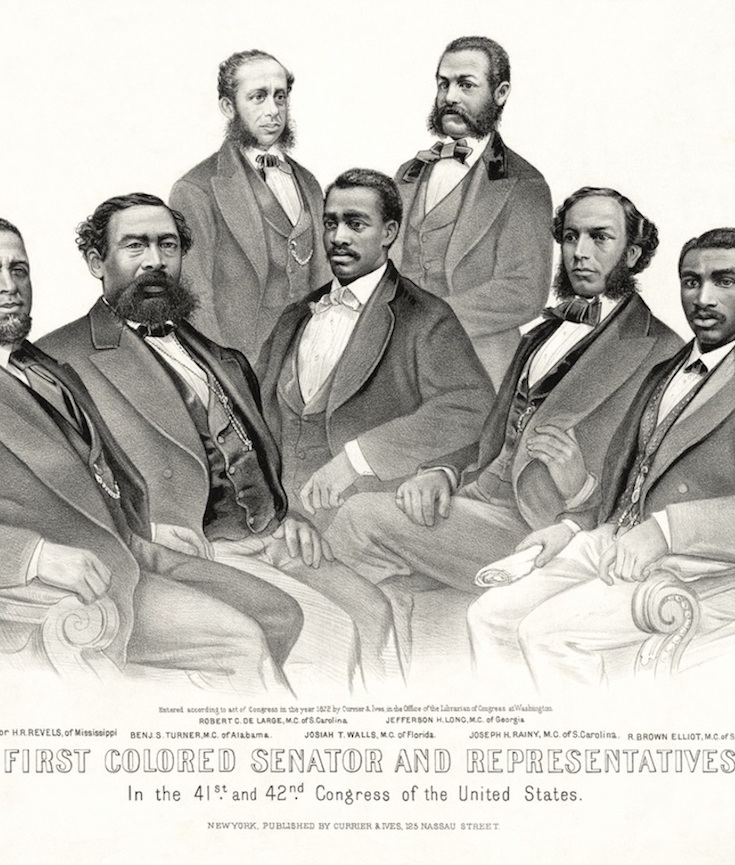[dropcap]Given[/dropcap] the sheer number of Confederate memorials, there is bound to be another shocking flashpoint of the kind that rocked Charlottesville and the nation. Stonewall Jackson and Robert E. Lee have vanished from Baltimore and New Orleans. Chief Justice Roger Taney, who authored the truly infamous part of the Dred Scott decision, is gone from Annapolis. So many have come down—or are up for possible removal—that The New York Times posted an interactive map to chart them all.
But there is an alternative politics of memory that Americans can also practice, and it might help to keep fascists out of public squares and do something concrete, literally at the same time: honor Reconstruction. Remembering Reconstruction ought not to shunt aside the politics of Confederate memorials. Yet remembering this pivotal era certainly deserves to be built into the new national politics of memory.
The sesquicentennial of Reconstruction is September 1, 2017. Under the First Military Reconstruction Act of March 1867, a Republican-controlled Congress, having become justifiably concerned about profound legal and extra-legal threats to the statutory civil rights of black Southerners, gave the U.S. Army an administrative deadline of September 1 to directly register all black and white adult males in 10 of the 11 ex-Confederate states (Tennessee, the 11th, already had a biracial electorate.) Echoing the Freedom Summer of the civil rights movement, University of Chicago historian Julie Saville has called the summer of 1867 “Registration Summer.”
[mc4wp_form id=”6042″]
 Hiram Revels | Brady-Handy Photograph Collection
Hiram Revels | Brady-Handy Photograph Collection
 Benjamin Sterling Turner | Brady-Handy Photograph Collection
Benjamin Sterling Turner | Brady-Handy Photograph Collection
 Robert Carlos De Large | Brady-Handy Photograph Collection
Robert Carlos De Large | Brady-Handy Photograph Collection
 Josiah Thomas Walls | Brady-Handy Photograph Collection
Josiah Thomas Walls | Brady-Handy Photograph Collection
 Jefferson Franklin Long | Brady-Handy Photograph Collection
Jefferson Franklin Long | Brady-Handy Photograph Collection
 Joseph Rainey | Brady-Handy Photograph Collection
Joseph Rainey | Brady-Handy Photograph Collection
HISTORICALLY BLACK COLLEGES & UNIVERSITIES | HBCU
Historically black colleges and universities (HBCUs) are institutions of higher education in the United States that were established before 1964 with the intention of primarily serving the African American community. They have always allowed admission to students of all races. Most were created in the aftermath of the American Civil War and are in the former slave states, although a few notable exceptions exist.
There are 107 HBCUs in the United States, including public and private institutions, community and four-year institutions, medical and law schools.
Most HBCUs were established after the American Civil War, often with the assistance of northern United States religious missionary organizations. However, Cheyney University of Pennsylvania (1837) and Lincoln University (Pennsylvania) (1854), were established for blacks before the American Civil War. In 1856 the AME Church of Ohio collaborated with the Methodist Episcopal Church, a predominantly white denomination, in sponsoring the third college Wilberforce University in Ohio. Established in 1865, Shaw University was the first HBCU in the South to be established after the American Civil War.
The Higher Education Act of 1965, as amended, defines a “part B institution” as: “…any historically black college or university that was established before 1964, whose principal mission was, and is, the education of black Americans, and that is accredited by a nationally recognized accrediting agency or association determined by the Secretary [of Education] to be a reliable authority as to the quality of training offered or is, according to such an agency or association, making reasonable progress toward accreditation.”Part B of the 1965 Act provides for direct federal aid to Part B institutions.
In 1862, the Federal government’s Morrill Act provided for land grant colleges in each state. Some educational institutions in the North or West were open to blacks before the Civil War. But 17 states, mostly in the South, had segregated systems and generally excluded black students from their land grant colleges. In response, Congress passed the second Morrill Act of 1890, also known as the Agricultural College Act of 1890, requiring states to establish a separate land grant college for blacks if blacks were being excluded from the existing land grant college. Many of the HBCUs were founded by states to satisfy the Second Morrill Act. These land grant schools continue to receive annual federal funding for their research, extension and outreach activities. The Higher Education Act of 1965 established a program for direct federal grants to HBCUs, including federal matching of private endowment contributions. (Wikipedia).


You must be logged in to post a comment.